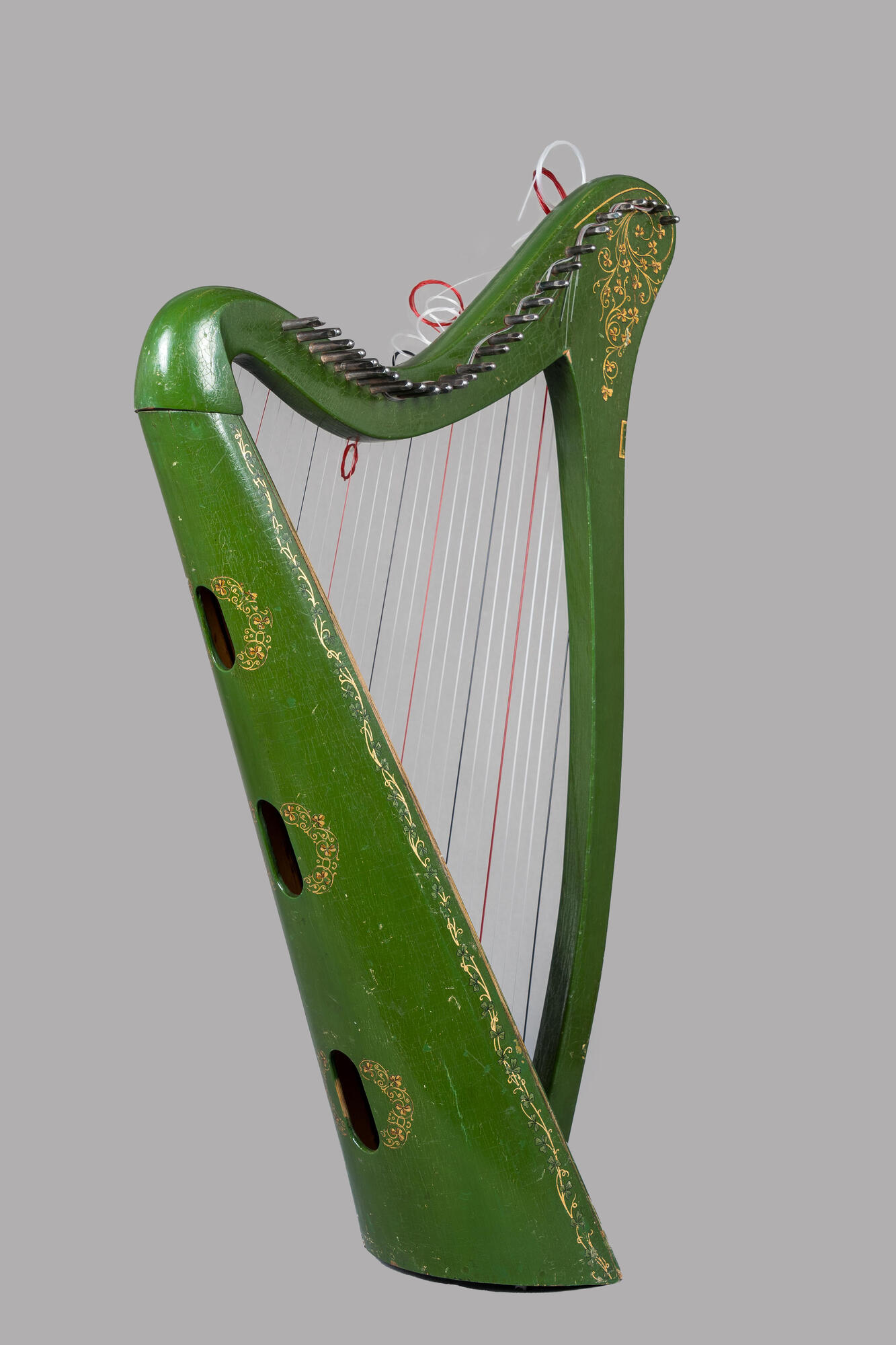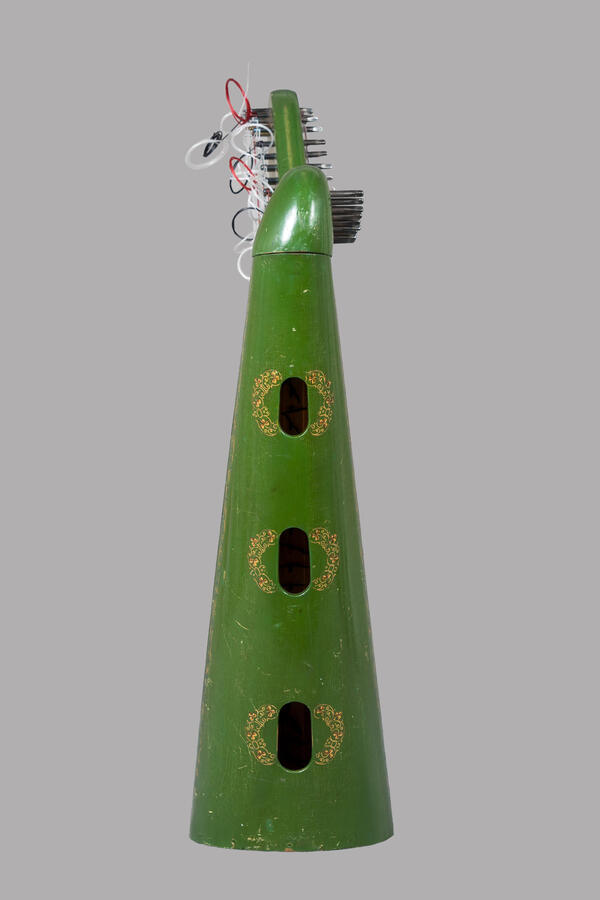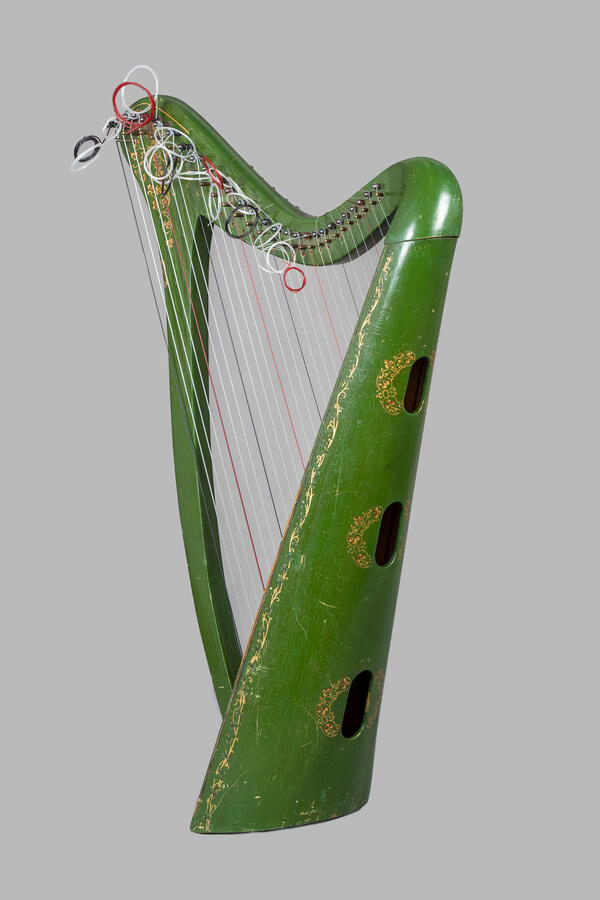The Irish harp is a small instrument with a wide body, a flat soundboard, and a gracefully curved neck. The harp should be held against the right shoulder, with notes in the lower register played with the left hand and notes in the higher register with the right hand. The instrument has diatonic strings that cover around three to four octaves.
The harp from the museum’s collection was made by the English manufacturer J. Morley in the 19th century. The harp historian John Marson suggests that the Morleys are one of the longest-established dynasties within the harp world. Their company was registered in London in 1817. Later it was renamed “Clive Morley Harps” after the name of its previous owner. This harp has 28 gut and metal strings. Its green body is richly decorated with a golden floral pattern.
The Irish harp often appears in Celtic myths and legends. Numerous stone carvings with the images of harps have been preserved in Irish provinces and in the west of Scotland. They were created between the 8th and the 10th centuries.
The traditional Irish harp was an integral element of the culture of professional bards and was mostly played at the royal court and houses of noblemen. In the 16th and 17th centuries, when the Irish were fighting for independence, the English Crown banned the use of Celtic harps. As a result, the instrument became almost extinct. Only in the late 18th century, the harp tradition started to revive.
The harp was used on Irish coinage and was adopted as a symbol of the Kingdom of Ireland founded by Henry VIII of England in 1542. Nowadays, Ireland is the only country in the world that has a musical instrument as its national symbol. Its coat of arms features a gold twelve-string harp on a blue background. It is also known as Brian Boru’s harp after the High King of Ireland.
The oldest surviving harp is displayed at Trinity College Dublin. Its graceful image is depicted on Irish postage stamps, seals, the badge of the Royal Irish Regiment of the British Army, and a beer manufacturer’s trademark. It has also inspired the design of the Samuel Beckett Bridge over the River Liffey in central Dublin.
The harp from the museum’s collection was made by the English manufacturer J. Morley in the 19th century. The harp historian John Marson suggests that the Morleys are one of the longest-established dynasties within the harp world. Their company was registered in London in 1817. Later it was renamed “Clive Morley Harps” after the name of its previous owner. This harp has 28 gut and metal strings. Its green body is richly decorated with a golden floral pattern.
The Irish harp often appears in Celtic myths and legends. Numerous stone carvings with the images of harps have been preserved in Irish provinces and in the west of Scotland. They were created between the 8th and the 10th centuries.
The traditional Irish harp was an integral element of the culture of professional bards and was mostly played at the royal court and houses of noblemen. In the 16th and 17th centuries, when the Irish were fighting for independence, the English Crown banned the use of Celtic harps. As a result, the instrument became almost extinct. Only in the late 18th century, the harp tradition started to revive.
The harp was used on Irish coinage and was adopted as a symbol of the Kingdom of Ireland founded by Henry VIII of England in 1542. Nowadays, Ireland is the only country in the world that has a musical instrument as its national symbol. Its coat of arms features a gold twelve-string harp on a blue background. It is also known as Brian Boru’s harp after the High King of Ireland.
The oldest surviving harp is displayed at Trinity College Dublin. Its graceful image is depicted on Irish postage stamps, seals, the badge of the Royal Irish Regiment of the British Army, and a beer manufacturer’s trademark. It has also inspired the design of the Samuel Beckett Bridge over the River Liffey in central Dublin.




